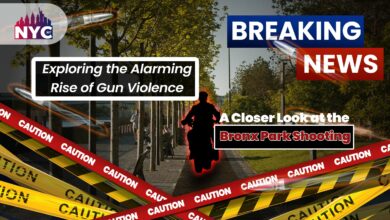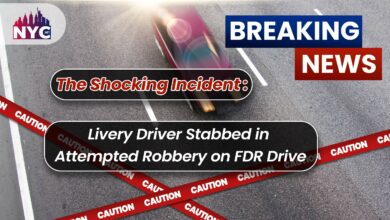The Impact of Ride-Sharing and Delivery Services on NYC Traffic Patterns.

Ride-Sharing and Delivery Services
Want to know more about the ride-sharing and delivery services in NYC? You are in the right place.
New York City is known for its bustling streets and heavy traffic. However, ride-sharing and delivery services have recently added a new element to the city’s transportation landscape. These services have become ubiquitous in NYC, including:
- Uber
- Lyft
- GrubHub
- DoorDash.
Undoubtedly, they offer convenience and accessibility to millions daily. Still, they also significantly impact traffic patterns throughout the city.
In this blog post, we’ll explore the following:
- Impact of Ride-sharing and delivery services on NYC’s Roads
- and their pros and cons for drivers and passengers alike.
Join me on this journey through one of the most exciting changes in New York City’s transportation history! Hence, let’s get into it:

History of Ride-Sharing and Delivery Services in NYC
Ride-sharing and delivery are now key parts of NYC’s transportation system. But how did it all begin?
It rules back to the 1900s. Though it gained popularity quite recently, its origin began long before.
Ride-sharing started as carpooling in the 1970s to decrease traffic and air pollution. However, ride-sharing took off only with mobile apps like:
- Uber.
- And Lyft.
In 2011, Uber launched its service in NYC with only a handful of vehicles on the road. The new service became popular in New York as it was easier and cheaper than the regular taxis. Over a short period, other firms grew in popularity among NYC commuters. These include:
- Lyft,
- Juno,
- and Via,
Food delivery is a concept that has been introduced previously. Ancient Romans used to order food using runners called “tractors.” Nowadays, in NYC, ordering food is easy with online platforms like:
- Grubhub
- DoorDash
- Seamless.
Hence, a simple click or phone call can deliver your food.
Today ride-sharing and delivery services remain at their peak in New York City despite occasional regulatory struggles from city officials.
These services changed how people travel within cities. They also give jobs to drivers and couriers.
Impact of Ride-Sharing and Delivery Services on NYC Traffic Patterns
Ride-sharing and delivery services in NYC have changed traffic patterns in the city. More cars are on the road during peak hours because more people use these services.
Ride Sharing:
Uber and Lyft, ride-sharing companies, have made travelling without owning a car in the city easier. However, this convenience comes at a cost. With more vehicles on the road, congestion levels have increased significantly. Such road congestion proves to be quite frustrating for people.
Hence, if we play smart, we can tackle this problem easily.
Delivery Services:
Services like Amazon Prime Now and Instacart have added to the heavy traffic in NYC. These services need drivers to deliver packages to customers’ doors. Drivers have to drive through busy streets and neighbourhoods.
While ride-sharing and delivery services provide many benefits, they have created new challenges for policymakers. City officials are partnering with these companies to find eco-friendly transportation options that are convenient for everyone.
We hope to see a positive change soon enough in the future. If this problem is tackled, it will be a massive turn point.
Hence, Ride-sharing and delivery services have significantly impacted NYC’s traffic patterns.
As these industries grow, policymakers and service providers must work together. Consequently, they can create sustainable transportation solutions that benefit everyone involved.
Pros and Cons of Ride-Sharing and Delivery Services in NYC
Furthermore, like everything, they also have some pros and cons. One can only evaluate something by weighing down the advantages and disadvantages.
Ride-sharing and delivery services have revolutionized the way New Yorkers get around. These services have benefits but also have drawbacks.
Here are some of the Major Pros and Cons:
Pros:
Massive Convenience
Both ride-sharing and delivery services are convenient for consumers. With just a few taps on a smartphone app, a car or meal can arrive at your doorstep within minutes. You can save time by avoiding parking hassles in busy areas or long restaurant lines.
Job Opportunities:
Another advantage is that these services provide job opportunities for drivers and couriers. Many people in NYC rely on ride-sharing and delivery jobs as their primary source of income.
Cons:
However, there are also downsides to these services, such as:
Traffic Congestion:
They add to traffic congestion in busy city areas, a big problem. Some studies suggest that ride-sharing companies may contribute to increased air pollution levels.
Safety Concerns:
Some people worry that ride-sharing services are safe for drivers and passengers. Assaults or harassment by drivers have been reported in many cities, like NYC.
Despite some issues, ride-sharing and delivery are now important in NYC. Technology is changing how we get around cities. It’s neat to see how it affects transportation.
The rise of ride-sharing and delivery services in NYC
The rise of ride-sharing and delivery services in NYC has been incredible. Over the past decade, these services have transformed how people move around and receive goods in the city.
It all started with Uber’s entry into New York City in 2011. The company disrupted traditional taxi services by introducing a more affordable and convenient option for transportation. Soon after, other ride-sharing companies like Lyft and Via followed suit.
Delivery services also saw a similar boom during this period, as companies like Seamless and Grubhub made it possible to order food from virtually any restaurant in the city with just a few taps on your smartphone screen.
As these services gained popularity among consumers, they also faced some pushback from traditional industries, such as taxis and restaurants, who felt threatened by their disruptive nature.
Despite this opposition, ride-sharing and delivery services continued to grow at an impressive pace. Today, they are an integral part of life in NYC – offering residents unparalleled convenience when getting around or ordering food without ever leaving their homes.
Ride-sharing and delivery services are going to change more in the future. New technologies like self-driving cars are already being tested in cities. These revolutionary solutions will continue to transform American cities. It’s safe to assume that we will see more of them.
The Future of Ride-sharing and delivery services in NYC
The future of ride-sharing and delivery services in NYC is promising. As technology advances, these services will become more efficient and convenient for drivers and consumers.
Here are some of the expected future implications of ride-sharing and delivery services in NYC:
Development of Electric and Autonomous Vehicles:
One area that is likely to see improvement is the development of electric and autonomous vehicles. Ride-sharing companies are investing heavily in this technology. Doing so will reduce emissions and make transportation safer.
Utilization of Public Transport System:
Another potential change is the integration of ride-sharing with public transportation systems. This could reduce traffic congestion as people opt for shared rides instead of driving.
Betterment of Services for Consumers:
In addition, ride-sharing companies may have greater competition as new players enter the market. This could result in improved pricing models and better service for consumers.
However, there are also concerns about the impact of ride-sharing on traditional taxi services and workers’ rights. It remains to be seen how policymakers will address these issues moving forward.
It’s clear that ride-sharing and delivery services have significantly impacted NYC traffic patterns, but their future role remains uncertain as technology continues to evolve.
Conclusion
Ride-sharing and delivery services have significantly impacted traffic patterns in New York City. These services made transport easier for many but caused more traffic too. These services have advantages, but we must consider how they affect the city and safety.
Regulations in NYC are changing, which affects ride sharing and delivery services. Their future could be clearer. These services may have to change to lessen the impact on traffic. One way could be to encourage carpooling or invest in eco-friendly vehicles.
To make progress, policymakers, service providers, and consumers must collaborate to find solutions that balance convenience, sustainability, and safety for the public. We should do this to keep ride-sharing and delivery services useful and help our cities.



